fuel pressure BMW M6 CONVERTIBLE 2015 F12M Owner's Manual
[x] Cancel search | Manufacturer: BMW, Model Year: 2015, Model line: M6 CONVERTIBLE, Model: BMW M6 CONVERTIBLE 2015 F12MPages: 230, PDF Size: 4.9 MB
Page 76 of 230
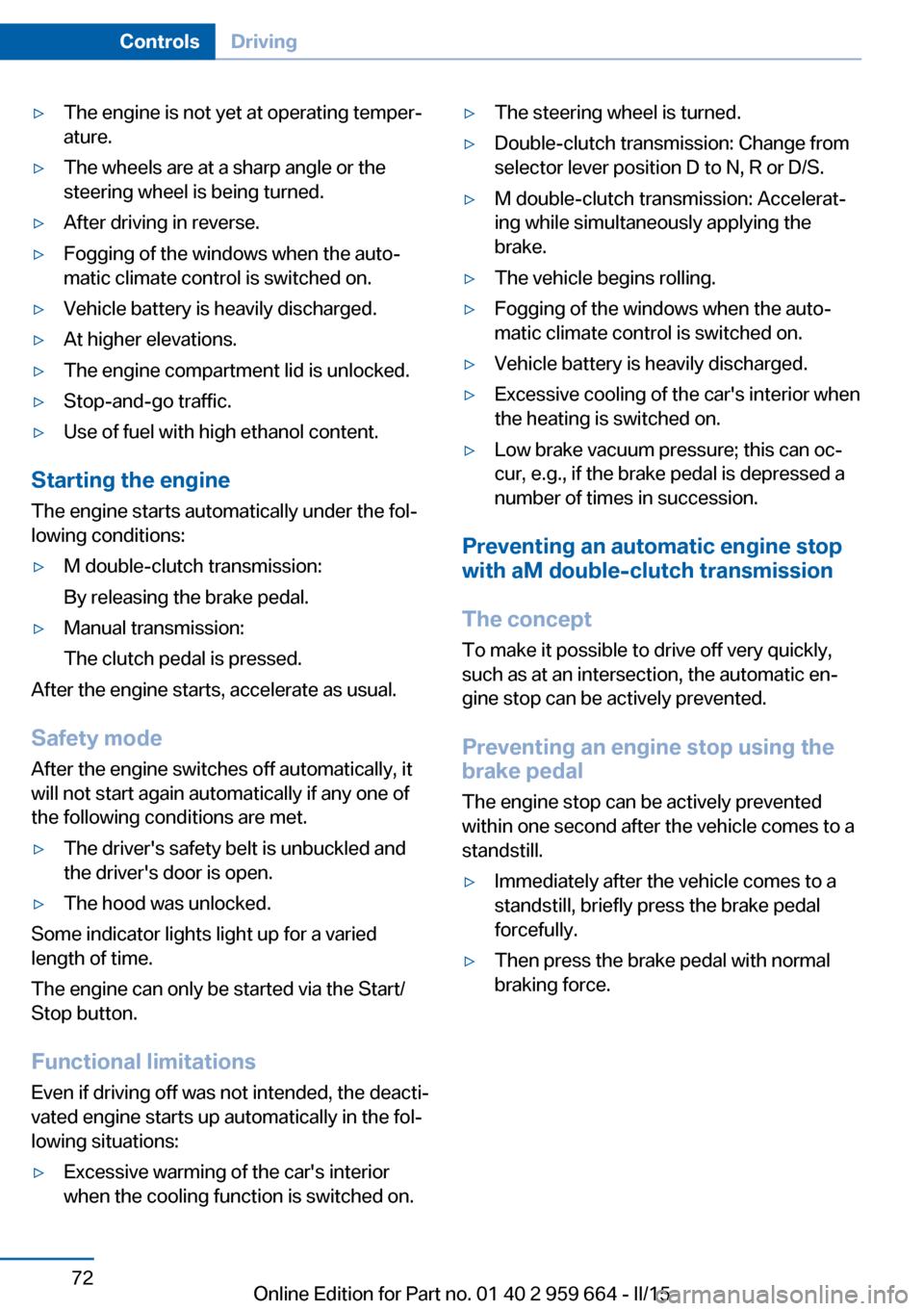
▷The engine is not yet at operating temper‐
ature.▷The wheels are at a sharp angle or the
steering wheel is being turned.▷After driving in reverse.▷Fogging of the windows when the auto‐
matic climate control is switched on.▷Vehicle battery is heavily discharged.▷At higher elevations.▷The engine compartment lid is unlocked.▷Stop-and-go traffic.▷Use of fuel with high ethanol content.
Starting the engine
The engine starts automatically under the fol‐
lowing conditions:
▷M double-clutch transmission:
By releasing the brake pedal.▷Manual transmission:
The clutch pedal is pressed.
After the engine starts, accelerate as usual.
Safety mode
After the engine switches off automatically, it
will not start again automatically if any one of
the following conditions are met.
▷The driver's safety belt is unbuckled and
the driver's door is open.▷The hood was unlocked.
Some indicator lights light up for a varied
length of time.
The engine can only be started via the Start/
Stop button.
Functional limitations
Even if driving off was not intended, the deacti‐
vated engine starts up automatically in the fol‐
lowing situations:
▷Excessive warming of the car's interior
when the cooling function is switched on.▷The steering wheel is turned.▷Double-clutch transmission: Change from
selector lever position D to N, R or D/S.▷M double-clutch transmission: Accelerat‐
ing while simultaneously applying the
brake.▷The vehicle begins rolling.▷Fogging of the windows when the auto‐
matic climate control is switched on.▷Vehicle battery is heavily discharged.▷Excessive cooling of the car's interior when
the heating is switched on.▷Low brake vacuum pressure; this can oc‐
cur, e.g., if the brake pedal is depressed a
number of times in succession.
Preventing an automatic engine stop with aM double-clutch transmission
The concept To make it possible to drive off very quickly,
such as at an intersection, the automatic en‐
gine stop can be actively prevented.
Preventing an engine stop using the
brake pedal
The engine stop can be actively prevented
within one second after the vehicle comes to a
standstill.
▷Immediately after the vehicle comes to a
standstill, briefly press the brake pedal
forcefully.▷Then press the brake pedal with normal
braking force.Seite 72ControlsDriving72
Online Edition for Part no. 01 40 2 959 664 - II/15
Page 116 of 230
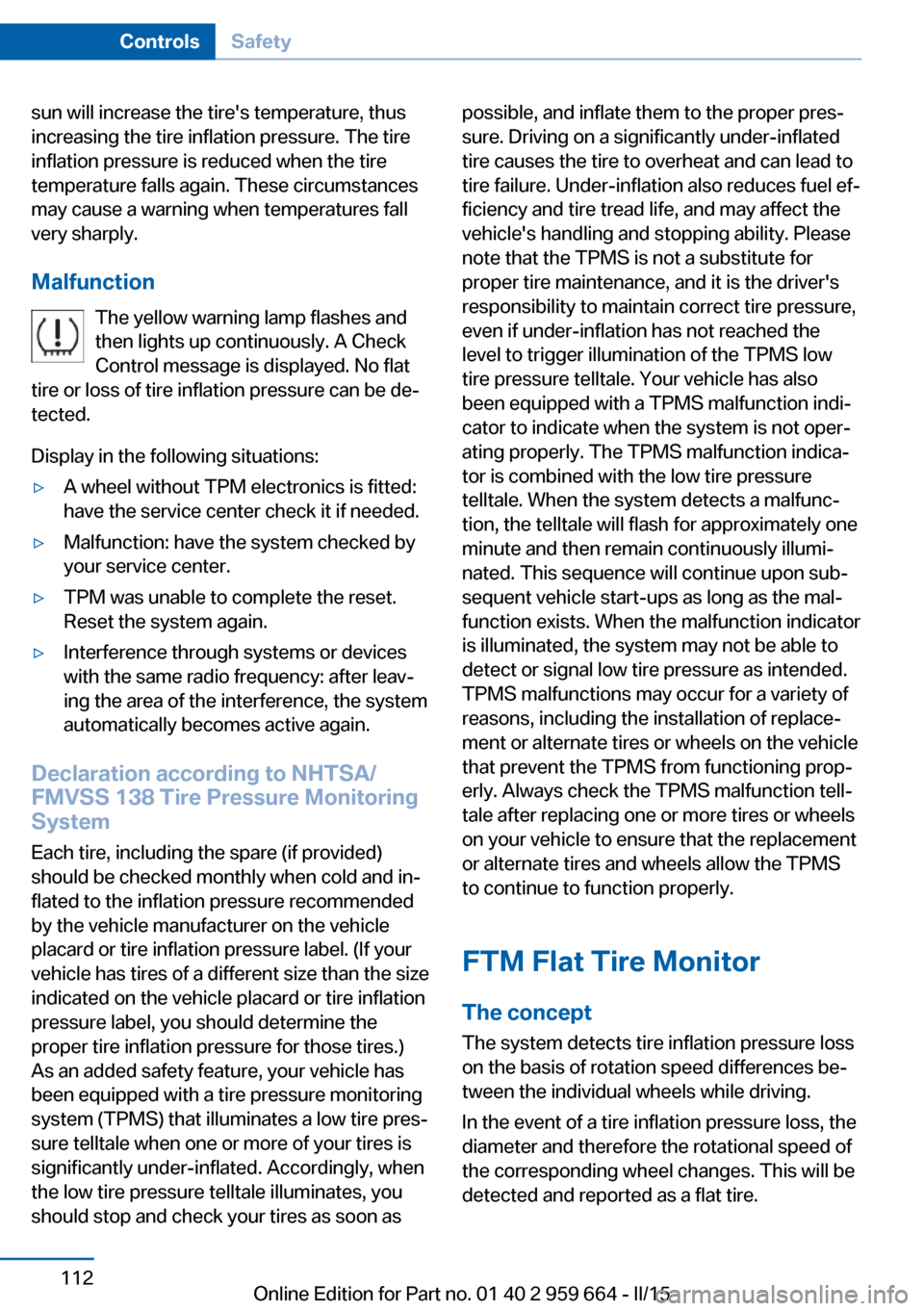
sun will increase the tire's temperature, thus
increasing the tire inflation pressure. The tire
inflation pressure is reduced when the tire
temperature falls again. These circumstances
may cause a warning when temperatures fall
very sharply.
Malfunction The yellow warning lamp flashes and
then lights up continuously. A Check
Control message is displayed. No flat
tire or loss of tire inflation pressure can be de‐
tected.
Display in the following situations:▷A wheel without TPM electronics is fitted:
have the service center check it if needed.▷Malfunction: have the system checked by
your service center.▷TPM was unable to complete the reset.
Reset the system again.▷Interference through systems or devices
with the same radio frequency: after leav‐
ing the area of the interference, the system
automatically becomes active again.
Declaration according to NHTSA/
FMVSS 138 Tire Pressure Monitoring
System
Each tire, including the spare (if provided)
should be checked monthly when cold and in‐
flated to the inflation pressure recommended
by the vehicle manufacturer on the vehicle
placard or tire inflation pressure label. (If your
vehicle has tires of a different size than the size
indicated on the vehicle placard or tire inflation
pressure label, you should determine the
proper tire inflation pressure for those tires.)
As an added safety feature, your vehicle has
been equipped with a tire pressure monitoring
system (TPMS) that illuminates a low tire pres‐
sure telltale when one or more of your tires is
significantly under-inflated. Accordingly, when
the low tire pressure telltale illuminates, you
should stop and check your tires as soon as
possible, and inflate them to the proper pres‐
sure. Driving on a significantly under-inflated
tire causes the tire to overheat and can lead to
tire failure. Under-inflation also reduces fuel ef‐
ficiency and tire tread life, and may affect the
vehicle's handling and stopping ability. Please
note that the TPMS is not a substitute for
proper tire maintenance, and it is the driver's
responsibility to maintain correct tire pressure,
even if under-inflation has not reached the
level to trigger illumination of the TPMS low
tire pressure telltale. Your vehicle has also
been equipped with a TPMS malfunction indi‐
cator to indicate when the system is not oper‐
ating properly. The TPMS malfunction indica‐
tor is combined with the low tire pressure
telltale. When the system detects a malfunc‐
tion, the telltale will flash for approximately one
minute and then remain continuously illumi‐
nated. This sequence will continue upon sub‐
sequent vehicle start-ups as long as the mal‐
function exists. When the malfunction indicator
is illuminated, the system may not be able to
detect or signal low tire pressure as intended.
TPMS malfunctions may occur for a variety of
reasons, including the installation of replace‐
ment or alternate tires or wheels on the vehicle
that prevent the TPMS from functioning prop‐
erly. Always check the TPMS malfunction tell‐
tale after replacing one or more tires or wheels
on your vehicle to ensure that the replacement
or alternate tires and wheels allow the TPMS
to continue to function properly.
FTM Flat Tire Monitor The conceptThe system detects tire inflation pressure losson the basis of rotation speed differences be‐
tween the individual wheels while driving.
In the event of a tire inflation pressure loss, the
diameter and therefore the rotational speed of
the corresponding wheel changes. This will be
detected and reported as a flat tire.Seite 112ControlsSafety112
Online Edition for Part no. 01 40 2 959 664 - II/15
Page 174 of 230

Saving fuelVehicle features and optionsThis chapter describes all standard, country-
specific and optional features offered with the
series. It also describes features that are not
necessarily available in your car, e. g., due to
the selected options or country versions. This
also applies to safety-related functions and
systems. The respectively applicable country
provisions must be observed when using the
respective features and systems.
General information Your vehicle contains advanced technology for
the reduction of fuel consumption and emis‐
sions.
Fuel consumption depends on a number of dif‐
ferent factors.
Carrying out certain measures, such as a mod‐
erate driving style and regular maintenance,
can influence fuel consumption and the envi‐
ronmental impact.
Remove unnecessary cargo
Additional weight increases fuel consumption.
Remove attached parts
following use
Attached parts on the vehicle impair the aero‐
dynamics and increase the fuel consumption.
Closing the windows Open windows increase air resistance and
therefore lead to greater fuel consumption.Tires
General information
Tires can affect fuel consumption in various
ways, e.g., tire size may influence fuel con‐
sumption.
Check the tire inflation pressure
regularly
Check and, if needed, correct the tire inflation
pressure at least twice a month and before
starting on a long trip.
Low tire inflation pressure increases rolling re‐
sistance and thus raises fuel consumption and
tire wear.
Drive away immediately
Do not wait for the engine to warm-up while
the vehicle remains stationary. Start driving
right away, but at moderate engine speeds.
This is the quickest way of warming the cold
engine up to operating temperature.
Look well ahead when
driving
Avoid unnecessary acceleration and braking.
By maintaining a suitable distance to the vehi‐
cle driving ahead of you.
Driving smoothly and proactively reduces fuel
consumption.
Avoid high engine speeds
As a rule: driving at low engine speeds lowers
fuel consumption and reduces wear.
Use 1st gear to get the vehicle moving. Start‐
ing with the 2nd gear, accelerate rapidly. WhenSeite 170Driving tipsSaving fuel170
Online Edition for Part no. 01 40 2 959 664 - II/15
Page 187 of 230
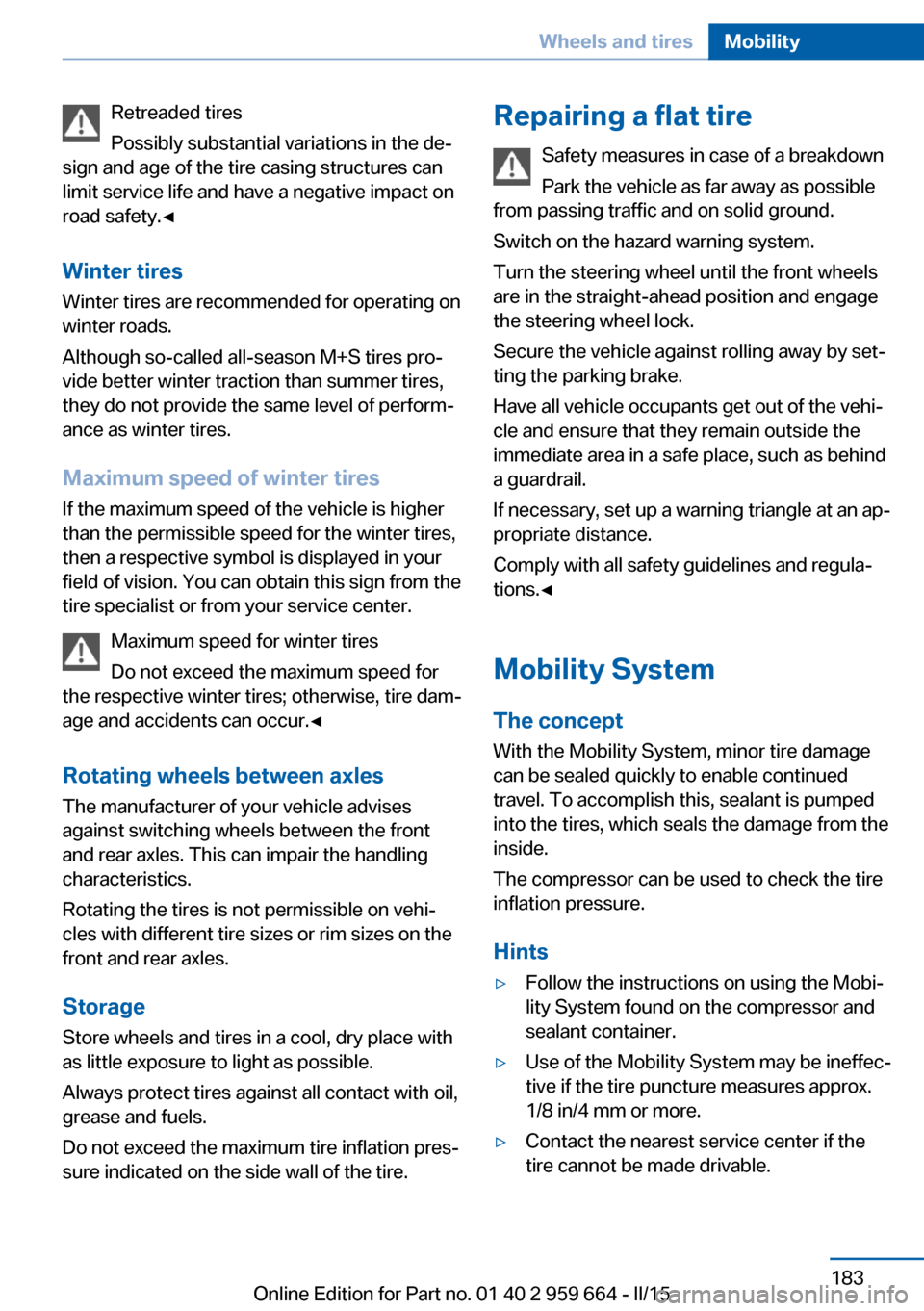
Retreaded tires
Possibly substantial variations in the de‐
sign and age of the tire casing structures can
limit service life and have a negative impact on
road safety.◀
Winter tires
Winter tires are recommended for operating on
winter roads.
Although so-called all-season M+S tires pro‐
vide better winter traction than summer tires, they do not provide the same level of perform‐
ance as winter tires.
Maximum speed of winter tires If the maximum speed of the vehicle is higher
than the permissible speed for the winter tires,
then a respective symbol is displayed in your
field of vision. You can obtain this sign from the
tire specialist or from your service center.
Maximum speed for winter tires
Do not exceed the maximum speed for
the respective winter tires; otherwise, tire dam‐
age and accidents can occur.◀
Rotating wheels between axles The manufacturer of your vehicle advises
against switching wheels between the front
and rear axles. This can impair the handling
characteristics.
Rotating the tires is not permissible on vehi‐
cles with different tire sizes or rim sizes on the
front and rear axles.
StorageStore wheels and tires in a cool, dry place with
as little exposure to light as possible.
Always protect tires against all contact with oil,
grease and fuels.
Do not exceed the maximum tire inflation pres‐
sure indicated on the side wall of the tire.Repairing a flat tire
Safety measures in case of a breakdown
Park the vehicle as far away as possible
from passing traffic and on solid ground.
Switch on the hazard warning system.
Turn the steering wheel until the front wheels are in the straight-ahead position and engage
the steering wheel lock.
Secure the vehicle against rolling away by set‐
ting the parking brake.
Have all vehicle occupants get out of the vehi‐
cle and ensure that they remain outside the
immediate area in a safe place, such as behind
a guardrail.
If necessary, set up a warning triangle at an ap‐
propriate distance.
Comply with all safety guidelines and regula‐
tions.◀
Mobility System
The concept With the Mobility System, minor tire damage
can be sealed quickly to enable continued
travel. To accomplish this, sealant is pumped
into the tires, which seals the damage from the
inside.
The compressor can be used to check the tire
inflation pressure.
Hints▷Follow the instructions on using the Mobi‐
lity System found on the compressor and
sealant container.▷Use of the Mobility System may be ineffec‐
tive if the tire puncture measures approx.
1/8 in/4 mm or more.▷Contact the nearest service center if the
tire cannot be made drivable.Seite 183Wheels and tiresMobility183
Online Edition for Part no. 01 40 2 959 664 - II/15
Page 220 of 230
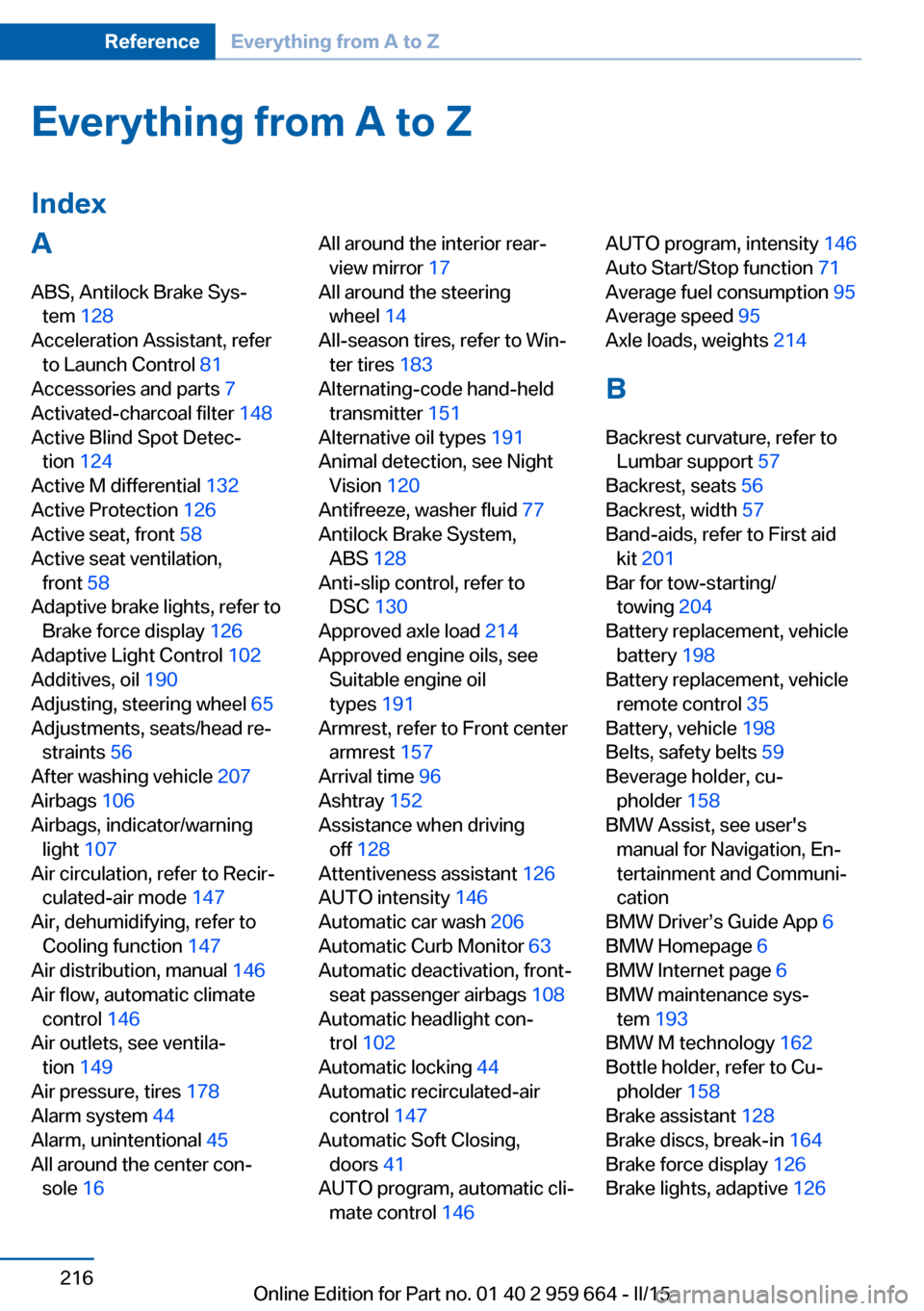
Everything from A to Z
IndexA ABS, Antilock Brake Sys‐ tem 128
Acceleration Assistant, refer to Launch Control 81
Accessories and parts 7
Activated-charcoal filter 148
Active Blind Spot Detec‐ tion 124
Active M differential 132
Active Protection 126
Active seat, front 58
Active seat ventilation, front 58
Adaptive brake lights, refer to Brake force display 126
Adaptive Light Control 102
Additives, oil 190
Adjusting, steering wheel 65
Adjustments, seats/head re‐ straints 56
After washing vehicle 207
Airbags 106
Airbags, indicator/warning light 107
Air circulation, refer to Recir‐ culated-air mode 147
Air, dehumidifying, refer to Cooling function 147
Air distribution, manual 146
Air flow, automatic climate control 146
Air outlets, see ventila‐ tion 149
Air pressure, tires 178
Alarm system 44
Alarm, unintentional 45
All around the center con‐ sole 16 All around the interior rear‐
view mirror 17
All around the steering wheel 14
All-season tires, refer to Win‐ ter tires 183
Alternating-code hand-held transmitter 151
Alternative oil types 191
Animal detection, see Night Vision 120
Antifreeze, washer fluid 77
Antilock Brake System, ABS 128
Anti-slip control, refer to DSC 130
Approved axle load 214
Approved engine oils, see Suitable engine oil
types 191
Armrest, refer to Front center armrest 157
Arrival time 96
Ashtray 152
Assistance when driving off 128
Attentiveness assistant 126
AUTO intensity 146
Automatic car wash 206
Automatic Curb Monitor 63
Automatic deactivation, front- seat passenger airbags 108
Automatic headlight con‐ trol 102
Automatic locking 44
Automatic recirculated-air control 147
Automatic Soft Closing, doors 41
AUTO program, automatic cli‐ mate control 146 AUTO program, intensity 146
Auto Start/Stop function 71
Average fuel consumption 95
Average speed 95
Axle loads, weights 214
B Backrest curvature, refer to Lumbar support 57
Backrest, seats 56
Backrest, width 57
Band-aids, refer to First aid kit 201
Bar for tow-starting/ towing 204
Battery replacement, vehicle battery 198
Battery replacement, vehicle remote control 35
Battery, vehicle 198
Belts, safety belts 59
Beverage holder, cu‐ pholder 158
BMW Assist, see user's manual for Navigation, En‐
tertainment and Communi‐
cation
BMW Driver’s Guide App 6
BMW Homepage 6
BMW Internet page 6
BMW maintenance sys‐ tem 193
BMW M technology 162
Bottle holder, refer to Cu‐ pholder 158
Brake assistant 128
Brake discs, break-in 164
Brake force display 126
Brake lights, adaptive 126 Seite 216ReferenceEverything from A to Z216
Online Edition for Part no. 01 40 2 959 664 - II/15
Page 223 of 230
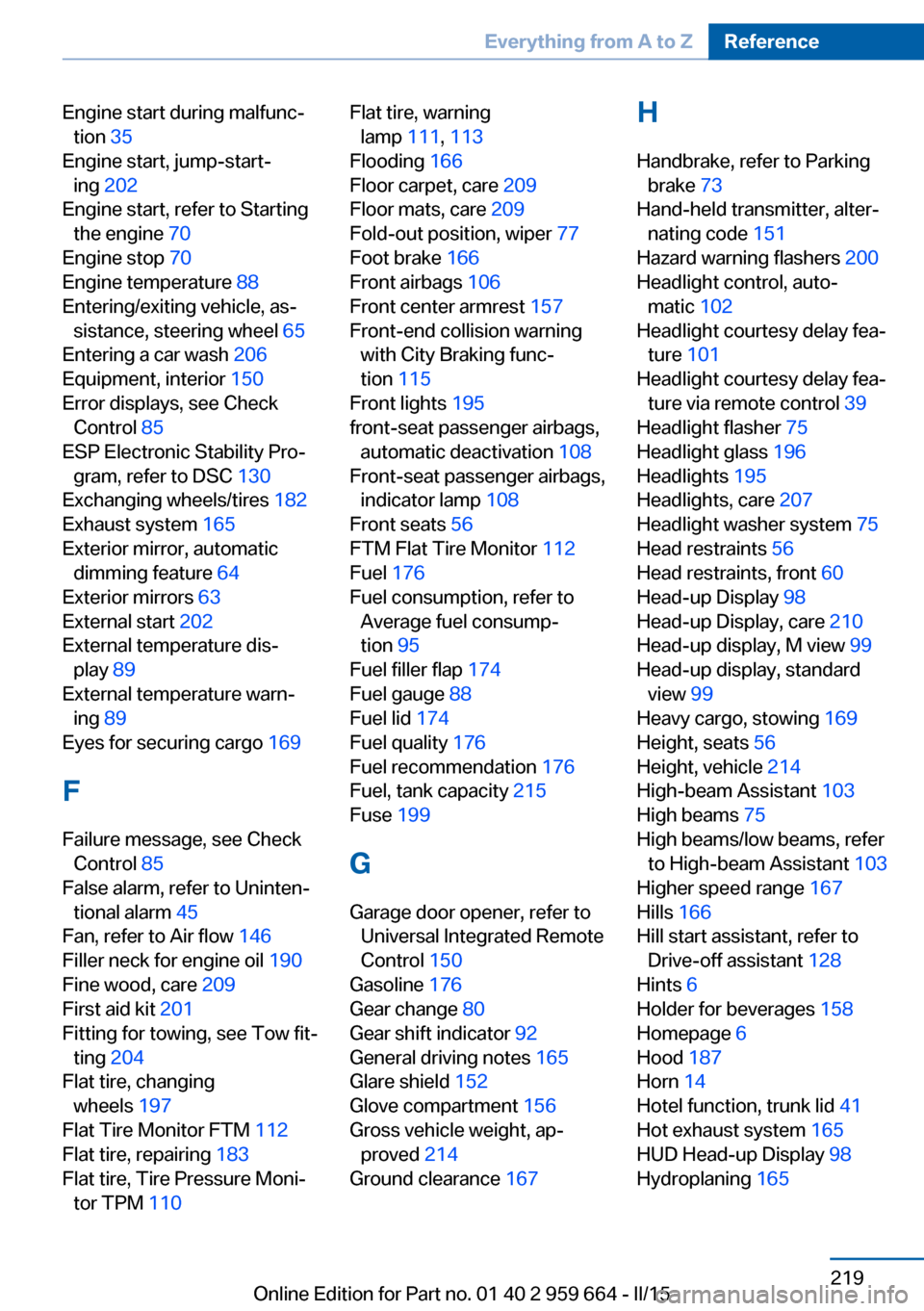
Engine start during malfunc‐tion 35
Engine start, jump-start‐ ing 202
Engine start, refer to Starting the engine 70
Engine stop 70
Engine temperature 88
Entering/exiting vehicle, as‐ sistance, steering wheel 65
Entering a car wash 206
Equipment, interior 150
Error displays, see Check Control 85
ESP Electronic Stability Pro‐ gram, refer to DSC 130
Exchanging wheels/tires 182
Exhaust system 165
Exterior mirror, automatic dimming feature 64
Exterior mirrors 63
External start 202
External temperature dis‐ play 89
External temperature warn‐ ing 89
Eyes for securing cargo 169
F
Failure message, see Check Control 85
False alarm, refer to Uninten‐ tional alarm 45
Fan, refer to Air flow 146
Filler neck for engine oil 190
Fine wood, care 209
First aid kit 201
Fitting for towing, see Tow fit‐ ting 204
Flat tire, changing wheels 197
Flat Tire Monitor FTM 112
Flat tire, repairing 183
Flat tire, Tire Pressure Moni‐ tor TPM 110 Flat tire, warning
lamp 111, 113
Flooding 166
Floor carpet, care 209
Floor mats, care 209
Fold-out position, wiper 77
Foot brake 166
Front airbags 106
Front center armrest 157
Front-end collision warning with City Braking func‐
tion 115
Front lights 195
front-seat passenger airbags, automatic deactivation 108
Front-seat passenger airbags, indicator lamp 108
Front seats 56
FTM Flat Tire Monitor 112
Fuel 176
Fuel consumption, refer to Average fuel consump‐
tion 95
Fuel filler flap 174
Fuel gauge 88
Fuel lid 174
Fuel quality 176
Fuel recommendation 176
Fuel, tank capacity 215
Fuse 199
G
Garage door opener, refer to Universal Integrated Remote
Control 150
Gasoline 176
Gear change 80
Gear shift indicator 92
General driving notes 165
Glare shield 152
Glove compartment 156
Gross vehicle weight, ap‐ proved 214
Ground clearance 167 H
Handbrake, refer to Parking brake 73
Hand-held transmitter, alter‐ nating code 151
Hazard warning flashers 200
Headlight control, auto‐ matic 102
Headlight courtesy delay fea‐ ture 101
Headlight courtesy delay fea‐ ture via remote control 39
Headlight flasher 75
Headlight glass 196
Headlights 195
Headlights, care 207
Headlight washer system 75
Head restraints 56
Head restraints, front 60
Head-up Display 98
Head-up Display, care 210
Head-up display, M view 99
Head-up display, standard view 99
Heavy cargo, stowing 169
Height, seats 56
Height, vehicle 214
High-beam Assistant 103
High beams 75
High beams/low beams, refer to High-beam Assistant 103
Higher speed range 167
Hills 166
Hill start assistant, refer to Drive-off assistant 128
Hints 6
Holder for beverages 158
Homepage 6
Hood 187
Horn 14
Hotel function, trunk lid 41
Hot exhaust system 165
HUD Head-up Display 98
Hydroplaning 165 Seite 219Everything from A to ZReference219
Online Edition for Part no. 01 40 2 959 664 - II/15
Page 226 of 230
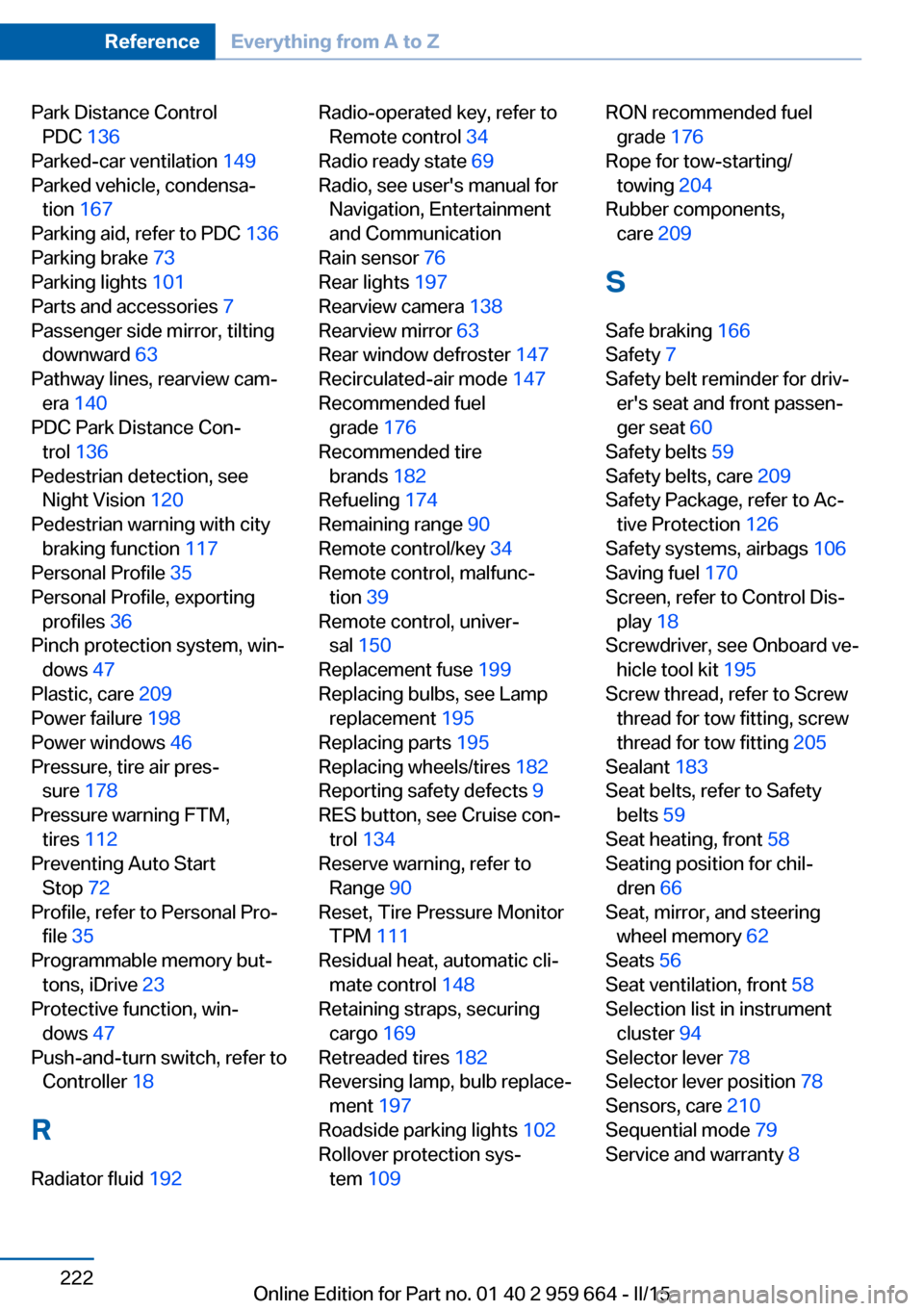
Park Distance ControlPDC 136
Parked-car ventilation 149
Parked vehicle, condensa‐ tion 167
Parking aid, refer to PDC 136
Parking brake 73
Parking lights 101
Parts and accessories 7
Passenger side mirror, tilting downward 63
Pathway lines, rearview cam‐ era 140
PDC Park Distance Con‐ trol 136
Pedestrian detection, see Night Vision 120
Pedestrian warning with city braking function 117
Personal Profile 35
Personal Profile, exporting profiles 36
Pinch protection system, win‐ dows 47
Plastic, care 209
Power failure 198
Power windows 46
Pressure, tire air pres‐ sure 178
Pressure warning FTM, tires 112
Preventing Auto Start Stop 72
Profile, refer to Personal Pro‐ file 35
Programmable memory but‐ tons, iDrive 23
Protective function, win‐ dows 47
Push-and-turn switch, refer to Controller 18
R Radiator fluid 192 Radio-operated key, refer to
Remote control 34
Radio ready state 69
Radio, see user's manual for Navigation, Entertainment
and Communication
Rain sensor 76
Rear lights 197
Rearview camera 138
Rearview mirror 63
Rear window defroster 147
Recirculated-air mode 147
Recommended fuel grade 176
Recommended tire brands 182
Refueling 174
Remaining range 90
Remote control/key 34
Remote control, malfunc‐ tion 39
Remote control, univer‐ sal 150
Replacement fuse 199
Replacing bulbs, see Lamp replacement 195
Replacing parts 195
Replacing wheels/tires 182
Reporting safety defects 9
RES button, see Cruise con‐ trol 134
Reserve warning, refer to Range 90
Reset, Tire Pressure Monitor TPM 111
Residual heat, automatic cli‐ mate control 148
Retaining straps, securing cargo 169
Retreaded tires 182
Reversing lamp, bulb replace‐ ment 197
Roadside parking lights 102
Rollover protection sys‐ tem 109 RON recommended fuel
grade 176
Rope for tow-starting/ towing 204
Rubber components, care 209
S
Safe braking 166
Safety 7
Safety belt reminder for driv‐ er's seat and front passen‐
ger seat 60
Safety belts 59
Safety belts, care 209
Safety Package, refer to Ac‐ tive Protection 126
Safety systems, airbags 106
Saving fuel 170
Screen, refer to Control Dis‐ play 18
Screwdriver, see Onboard ve‐ hicle tool kit 195
Screw thread, refer to Screw thread for tow fitting, screw
thread for tow fitting 205
Sealant 183
Seat belts, refer to Safety belts 59
Seat heating, front 58
Seating position for chil‐ dren 66
Seat, mirror, and steering wheel memory 62
Seats 56
Seat ventilation, front 58
Selection list in instrument cluster 94
Selector lever 78
Selector lever position 78
Sensors, care 210
Sequential mode 79
Service and warranty 8 Seite 222ReferenceEverything from A to Z222
Online Edition for Part no. 01 40 2 959 664 - II/15